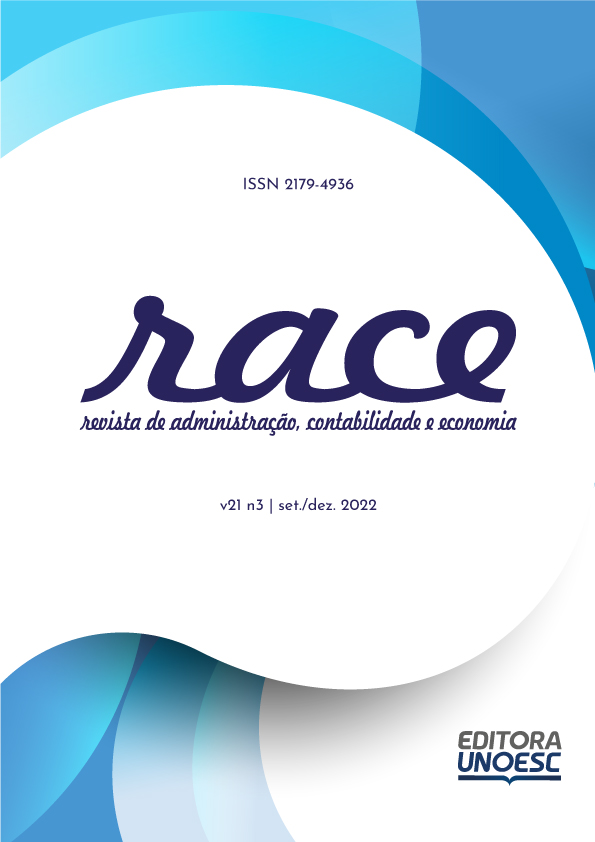Propensity for Credit Usage in Brazil (2012-2023): Empirical aspects of intertemporal choice
DOI:
https://doi.org/10.18593/race.32948Keywords:
Credit, Intertemporal Choice, Debt, Time SeriesAbstract
The present article focuses on the use of credit by Brazilian households. Its objective was to identify the efects of theoretical factors from the intertemporal choice model related to credit usage in Brazil. The theoretical model addressed was the intertemporal choice model from a microeconomic perspective, along with its implications in the Permanent Income Hypothesis and the Life Cycle Hypothesis. The study utilizes data from the Time Series Manager System of the Central Bank of Brazil, encompassing income, expectations, savings, interest rates, inflation, indebtedness, and default, employing VAR-VEC econometric modeling. The main results indicate that savings formation aligns with the analyzed theoretical model, while indebtedness exhibited expected behavior concerning expectations, inflation, and default, a variable added based on the literature review.
Downloads
References
Agarwal, S., Chomsisengphet, S., Mahoney, N., & Stroebel, J. (2018). Do banks pass through credit expansions to consumers who want to borrow? The Quarterly Journal of Economics, 133(1), 129-190. DOI: https://doi.org/10.1093/qje/qjx027
Ahrens, S., Bosch-Rosa, C., & Meissner, T. (2022). Intertemporal consumption and debt aversion: a replication and extension. Journal of the Economic Science Association, 8(1-2), 56-84. DOI: https://doi.org/10.1007/s40881-022-00118-y
Araujo, V. L. F. C. (2019). BNDES, BB e CEF: os bancos públicos federais e o mercado de crédito bancário brasileiro. In M. S. Silva, F. H. Schmidt, & P. Kliass (Eds.), Empresas estatais: políticas públicas, governança e desempenho, (Vol. 1, pp. 261-295). Brasília: Ipea.
Aycinena, D., Blazsek, S., Rentschler, L., & Sprenger, C. (2022). Intertemporal choice experiments and large-stakes behavior. Journal of Economic Behavior & Organization, 196, 484-500. DOI: https://doi.org/10.1016/j.jebo.2022.02.011
Bazzi, S., Muendler, M. A., Oliveira, R. F., & Rauch, J. E. (2023). Credit Supply Shocks and Firm Dynamics: Evidence from Brazil (No. w31721). National Bureau of Economic Research. DOI: https://doi.org/10.3386/w31721
Binger, B. R., & Hoffman, E. (1988). Microeconomics with calculus. São Paulo: Pearson.
Bueno, R. D. L. D. S. (2018). Econometria de séries temporais. São Paulo: Cengage.
Costa, C. J., Jr. (2016). Understanding DSGE models: theory and applications. Vernon Press.
Carlin, W., & Soskice, D. (2005). Macroeconomics: imperfections, institutions, and policies. OUP Catalogue.
Chantarát, S., Lamsam, A., Samphantharak, K., & Tangsawasdirat, B. (2020). Household debt and delinquency over the life cycle. Asian Development Review, 37(1), 61-92. DOI: https://doi.org/10.1162/adev_a_00141
Dick, C. D., & Jaroszek, L. (2013). Knowing what not to do: financial literacy and consumer credit choices. ZEW discussion papers, 13. DOI: https://doi.org/10.2139/ssrn.2278835
Dickey, D. A., & Fuller, W. A. (1979). Distribution of the estimators for autoregressive time series with a unit root. Journal of the American statistical association, 74(366a), 427-431. DOI: https://doi.org/10.1080/01621459.1979.10482531
Dickey, D. A., & Fuller, W. A. (1981). Likelihood ratio statistics for autoregressive time series with a unit root. Econometrica: journal of the Econometric Society, 1057-1072. DOI: https://doi.org/10.2307/1912517
Elliott, G., Rothenberg, T. J., & Stock, J. H. (1992). Efficient tests for an autoregressive unit root. DOI: https://doi.org/10.3386/t0130
Fulford, S. L. (2015). How important is variability in consumer credit limits? Journal of Monetary Economics, 72, 42-63. DOI: https://doi.org/10.1016/j.jmoneco.2015.01.002
Galashin, M., Kanz, M., & Perez-Truglia, R. (2020). Macroeconomic Expectations and Credit Card Spending. National Bureau of Economic Research. DOI: https://doi.org/10.3386/w28281
Hübner, M. A. (2016). O aumento do limite do cartão de crédito e sua influência no comportamento de gasto de consumidores. São Paulo: Insituto Insper.
Jardim, E., & Lorrany, L. (2020). Evolução recente do mercado de crédito imobiliário no Brasil. Radar, 63. DOI: https://doi.org/10.38116/radar63art2
Johansen, S. (1988). Statistical analysis of cointegration vectors. Journal of economic dynamics and control, 12(2-3), 231-254. DOI: https://doi.org/10.1016/0165-1889(88)90041-3
Kimutai, C. J., & Ambrose, J. (2013). Factors influencing credit rationing by commercial banks in Kenya. International Journal of Humanities and Social Science, 3(20), 244-252
Kunkel, F. I., Vieira, K. M., Coronel, D. A., Bender Filho, R. E. I. S. O. L. I., & Campara, J. P. (2013). Comportamento de Risco Financeiro dos Estudantes Universitários no Uso do Cartão de Crédito: uma Análise Comportamental. XVI SemeAd–Seminários em Administração, 16.
Meissner, T. (2016). Intertemporal consumption and debt aversion: an experimental study. Experimental Economics, 19, 281-298. DOI: https://doi.org/10.1007/s10683-015-9437-0
Metawa, N., Hassan, M. K., & Elhoseny, M. (2017). Genetic algorithm based model for optimizing bank lending decisions. Expert Systems with Applications, 80, 75-82. DOI: https://doi.org/10.1016/j.eswa.2017.03.021
Naerum, K., & Vernekohl, I. (2012). Consumer credit usage and over-indebtedness in low-income households. Unpublished master's thesis. Institute of Development Research and Development Policy, Ruh: Universität Bochum.
Negri, J. A., Alves, P. F., Koyama, S. M., & Araújo, B. C. (2022). Elasticidades, juros e prazo da demanda de crédito livre e direcionado no Brasil. São Paulo: Ipea.
Perlin, M. (2021). GetBCBData: Imports Datasets from BCB (Central Bank of Brazil) using Its Official API (Version 0.6) [Manual]. https://CRAN.R-project.org/package=GetBCBData
R Core Team. (2021). R: A Language and Environment for Statistical Computing. R Foundation for Statistical Computing. Vienna, Austria. https://www.R-project.org/
Ramcharran, H. (2020). Analyzing the impact of workers’ remittances on household consumption in Latin American and Caribbean Countries. Journal of Economics and Finance, 44, 59-77. DOI: https://doi.org/10.1007/s12197-019-9468-z
Silva, J. M. D. (2020). Crédito consignado: perfil dos servidores da UFRPE e a propensão ao risco de endividamento [Master's thesis, Universidade Federal de Pernambuco].
Souza, M. A. P. D. (2013). O uso do crédito pelo consumidor: percepções multifacetadas de um fenômeno intertemporal. [Dissertação de Mestrado, Universidade de Brasília].
Torquato, J. F. N. (2014). Uso do crédito: abordagem sobre consumos individuais.
Vieira, K. M., Kunkel, F. R., & Paraboni, A. L. (2015). Propensão à dívida no cartão de crédito: quais são os aspectos determinantes? Revista Pensamento Contemporâneo em Administração, 9(3), 102-120. DOI: https://doi.org/10.12712/rpca.v9i3.519
Zeidan, R. (2020). Why is bank credit in Brazil the most expensive in the world? Brazilian Review of Finance, 18(4), 1-22. DOI: https://doi.org/10.12660/rbfin.v18n4.2020.81507
Published
How to Cite
Issue
Section
License
Copyright (c) 2024 Raquel Gomes, Hilder André Bezerra Farias

This work is licensed under a Creative Commons Attribution-NonCommercial 4.0 International License.
RACE – Business, Accounting and Economy Journal from Publisher Unoesc is licenced with a Licence Creative Commons – Noncommercial Attribution 4.0 International.



























